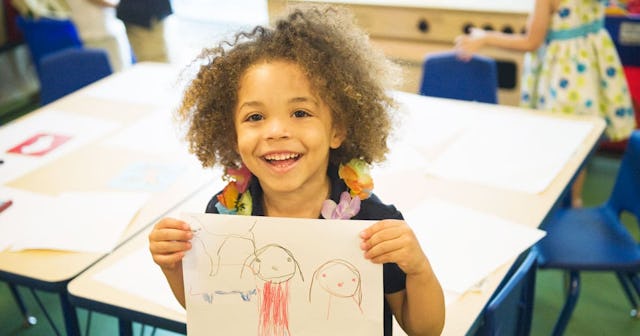11 Ways To Slay K––From A Kinder Teacher Of 40 Years

So your precious one is going to start kindergarten. When did that happen? Wasn’t it just yesterday you were sitting in a hospital room in awe at those tiny fingers and rosebud lips? You may not be ready, but your child needs to be.
During these strange, unprecedented days, you have so many decisions to make. Neighborhood school? Private school? Home School? Or should you just move to a desert island and start your own new world?
Whatever you decide, you owe it to your child to be school-ready. Things have ramped up since your day, Gen Z. Don’t obsess about it, but don’t throw away your shot.
Here are some important things a teacher would want you and your child to know before the first day:
Writing their name.
It doesn’t have to be neat, just fairly legible. Only the first letter is a capital. You can practice at home by writing this with a highlighter and letting your child trace it.
Counting to 20.
This is learned by rote, so count out loud any time you get a chance. Telephone poles, steps, eggs, buttons, etc. If you are ambitious, count by tens, too.
Counting to 10 with correspondence.
Your child should be able to touch objects and count them. If you put eight pennies on the table, she should touch each one as she counts. She also should be able to identify the numerals 1-10.
Putting things where they belong.
Maskot/Getty
Do you clean up toys because it’s just easier that way? We all do sometimes, but schoolchildren are expected to keep their materials organized. Have containers for things that are alike and label them.
Going to the bathroom.
If you still say “Do you need to go potty?” stop immediately. Your child will be entering school with older children and that phrase is deemed the hallmark of a baby. Find out how near the bathroom is to the classroom and if the toilets have automatic flush. You may need to make a bathroom visit at school before the first day.
Handling a backpack.
Let your child pick one they like. Many children collect and swap key chains to hang on the zipper to identify their bags. Don’t put in stuffed animals, blankets, lovies, etc. If you send the teacher a note, pin it on the outside. If your school allows water bottles, put it in the mesh pocket on the side.
Lunchbox or tray?
Kindergartners have enough new things to deal with. School lunch may be too much on the first day. A Mommy-made lunch feels like a big hug. Don’t forget a love note. Don’t be upset if your child wants a school tray on day two. Especially if it’s pizza.
Using a correct pencil grip.
krisanapong detraphiphat/Getty
Your child will be writing from the first day of class. An incorrect pencil grip will make things harder and has to be corrected. The research on beginning pencils is still out. The old school rule was fat pencils only. Then it was fat until Christmas and #2’s in January. Now it is anything goes, even golf pencils. But the grip is still important. You can get a plastic grip from any office supply store. Reverse it for lefties.
The ABCs.
This does not mean singing the song that ends with “Next time won’t you sing with me?” This means being able to identify all upper and lower case letters out of order. That sounds hard, but it is as easy as getting (or making) a set of flashcards and playing the game of three seconds. If your child says it, they get the card. If not, you get the card. Play once a day. You may find you will not have to teach a younger sibling because they learned this game over their brother’s shoulder.
Having a positive attitude.
I mean you, Mama and Daddy. You have done a great job. Your baby bird is about to take their first tiny flight away from you. But they are looking hard at you for clues. Is this a good thing? Should I be happy? Scared? If you say, “You’ll probably cry,” your child will. If you cry, they will too. But if you show enthusiasm and confidence that they are going to slay it, they will. Take pictures. Applaud like your child is a rock star. Keep a smile on your face even if you are holding back tears.
Wearing a mask.
Your child will undoubtedly have to wear a mask. Make sure they have two that fit: One on their face, one in their bookbag. Don’t give a scary lecture. Masks will come off. Masks will be worn incorrectly. Masks will be traded and get lost. Teachers will gently replace them and sing songs about it. Frightened children are not learning children. Masks are like shoes. Yes, it’s a pain to wear them but just put ‘em on.
Your child is a masterpiece. Now it is time to share them with the world.
This article was originally published on